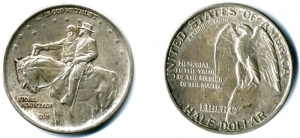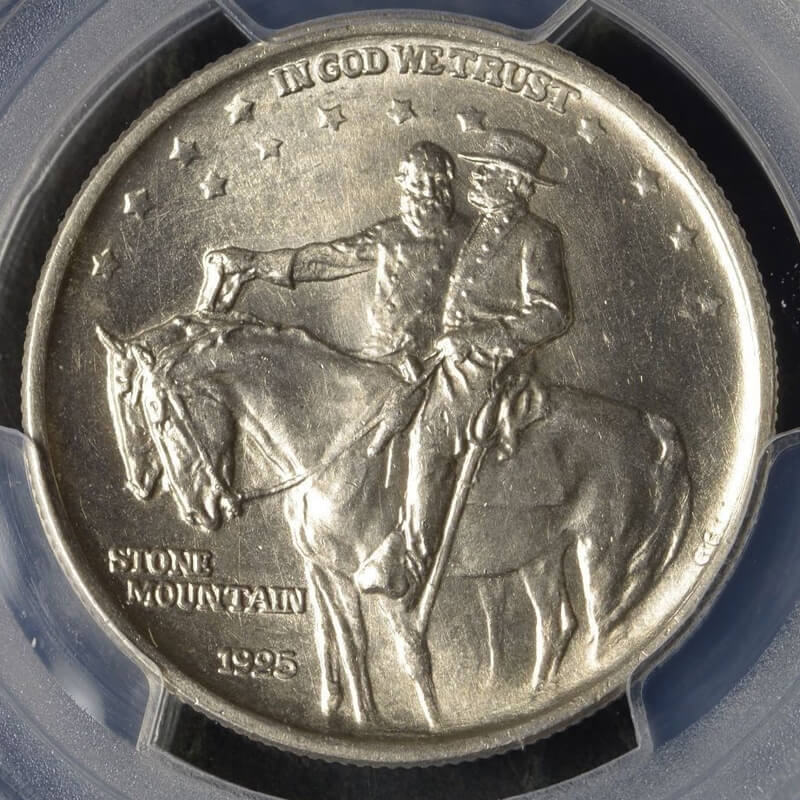By Dave Meisky
(Scroll down for images of the coins mentioned in this article)
Most people are aware of Confederate paper money but did the Confederacy mint coins? This is a difficult question as there are two possible answers: “Yes, but…” or “No, however…” In 1861 there were five United States mints. Two of them, the main mint in Philadelphia and the newest mint in San Francisco, were in states that remained in the Union while the mints in Charlotte, North Carolina; Dahlonega, Georgia; and New Orleans were in what became the Confederate States. Of these three, New Orleans was the largest while the other two were smaller operations that had been established in the early 1840s to take advantage of gold strikes in these areas.
In January of 1861, the Federal government produced about 330,000 silver (actually 90 percent silver and 10 percent copper) half dollars at New Orleans. When Louisiana seceded the state took over the mint and continued production, turning out about 124,000 of the coins. They used the original die (the die is what actually creates the image on the blank coin) so their coins still said “United States of America.” The Confederate Treasury Department then took over and minted another 963,000 United States half dollars. Coins of this period contained approximately the amount of metal equal to the face value of the coin and these Louisiana- and Confederate-produced coins had the same amount of silver as the U.S.-produced coins and were thus just as valuable. There is no way to determine if an individual coin was minted by the U.S., Louisiana, or the Confederacy as the same workers used the same die and machines and the coins had the same amount of silver.
Louisiana and the Confederacy also minted United States double eagle ($20) gold coins in New Orleans. The product runs for these coins was about 5,000 by the U.S., 9,750 by Louisiana, and 2991 by the Confederacy. The South also minted a total of approximately 10,000 United States gold $1 and $5 coins at Charlotte and Dahlonega before running out of stock and closing down these two operations.
The Confederate States, as an independent nation, wanted to produce their own coins, not just copy U.S. coins, so it was decided to mint Confederate silver half dollars. The first thing everyone recognized was that Miss Liberty was a southern belle, not a Yankee, so her image as it appeared on the U.S. half dollar could also appear on the Confederate coin, meaning that a new die would not have to be created. Manufacturing the die was the hardest and most technical challenging aspect of coining. A new die was created for the reverse side of the coin and four of the coins were struck and given to four individuals. The idea was that the coins would be examined and a decision made as to whether production would continue with that design. The fall of New Orleans in the spring of 1862 ended Confederate control of the New Orleans mint so no more of these coins were produced.
These four Confederate half dollars have an interesting post-war history. They were out of sight for a number of years in private hands but over the course of time they reappeared in public view. The first surfaced in 1879 when the man who had initially received it, Mr. B. F. Taylor, the chief coiner of the New Orleans Mint in 1861, sold it along with the die for the reverse, Confederate, side of the coin. This coin in now in the American Numismatic Association’s collection.
The next, which had been given to Dr. E. Adams of New Orleans, did not appear until 1910 when a collector found it in a wrapped roll of half dollars he received from a bank. It is now the property of the Newman Numismatic Education Society.
The third has the most interesting history. It was given to the mint superintendent, William Elmore, who sent it to Secretary of the Treasury Christopher Memminger, who in turn passed it on to President Jefferson Davis. It was with Davis when he left Richmond on April 2, 1865, and was in his wife’s luggage when he was captured in George. On the boat trip to Fortress Monroe, the luggage was searched and the coin was pilfered. When it reappeared at an auction in 1938 it was being sold as a Scott restrike (more about them later), although its authenticity as one of the original four was later established.
The last came to public view in 1971 after passing through several owners, starting with the 1861 New Orleans Postmaster John Riddell. The Davis and Riddell coins were both sold in separate auctions several months ago with the Davis coin commanding a high bid of $881,250 while the Riddell was a steal at $646,250.
The first of these Confederate half dollars was sold, along with the die, in 1879 to John W. Scott. The die was not in the best condition but Scott cleaned it up and decided to produce some restrikes. Since he didn’t have a die for the Miss Liberty face of the coin, he produced 500 tokens with the Confederate side and a message on the front that this was a restrike from an original die. This worked well, so he decided to produce 500 coins resembling the originals. Since he didn’t have the Miss Liberty die, he obtained 500 original 1861 half dollars, shaved the backs smooth, and then used the Confederate die to strike an image on the shaved surface. The result was a real 1861 U.S. half dollar that appears to be a Confederate half dollar although of slightly less weight due to the shaving of the back and with a slightly flattened Miss Liberty image because of pressure during the restrike. As previously mentioned, when the original Davis coin appeared in 1938 it was first thought to be one of these restrikes. Mr. Scott then defaced the die so there would be no more restrikes, thus helping to maintain the value of his coins. The die went through several hands until some years later when the listed owner stated he had donated it to the Louisiana State Historical Society. The Society checked its holdings and could not find the die nor could it find any record that it had ever been donated. Keep your eyes open because somewhere out there in the land of auctions, flea sales, and antique stores may be the Confederate half dollar die.
There was a period of about two months from February to April of 1861 when the Confederate States was an established nation but there was as yet no war. In late February the Confederate Treasury Department contracted with a company in Philadelphia to produce pennies (one cent coins) for the Confederacy. The job was assigned to Mr. Robert Lovett ,who designed the coin, created the die, and produced 12 samples, in nickel, to be sent to Richmond for approval. However a slight snag developed: The war had started and producing Confederate coins in Philly didn’t seem like the greatest of ideas to Mr. Lovett. Not wanting to get in trouble with Federal authorities, he buried the twelve coins and the two dies in his basement and kept his mouth shut. The Confederate Treasury never heard from him, and given the conditions never expected to hear from him, and so assumed that nothing had been produced.
Following the war Lovett did two things: He dug up and started carrying one of the coins as a good luck piece and he became somewhat of a drunk. One evening in 1871 he was engaged in his favorite activity and when he settled his bar tab he wasn’t paying attention, or was beyond paying attention, and gave the bartender the Confederate penny. Barkeeps are notably sharp-eyed when it comes to customer payments and he spotted the unusual coin. The cat, or in this case the coin, was out of the bag and Mr. Lovett ended up selling the twelve coins and the two dies to a collector named John Haseltine.
Haseltine sold the 12 coins (one of them fetched $141,000 at a recient auction) and decided to produce a limited number of restrikes in various metals. The originals were made of nickel, so he produced seven coins in gold, 12 in silver, and 55 in copper. He then defaced both dies. These defaced dies were obtained some years later by Robert Bashlow, who in 1961 did restrikes with the damaged die: 2,500 in silver, 5,000 in goldine, and 10,000 copper. The dies were then donated to the Smithsonian Institute.
This brings us back to the original question: Did the Confederacy mint coins? YES, BUT they were all U.S. coins except for four half-dollar coins plus 12 one-cent coins someone else minted that the Confederate government never actually owned. NO, HOWEVER there are a very limited number of samples that were minted by, or for, the Confederacy in addition to a number of non-Confederate coins that they produced. If you go to the gift shop at any battlefield or historical site you will probably be able to buy reproductions of the penny and half dollar and perhaps some reproductions of Confederate coins that never existed such as $5 and $20 imaginary gold coins. The pennies and half dollars are sometimes labeled “restrikes” but they are not. A restrike is made with the original die while these are reproductions. There was discussion during the war about producing Confederate gold coins but no design or samples were ever created.
An interesting side note is that although the image of Robert E. Lee never appeared on any Confederate bill or coin it has appeared on at least two United States coins: the 1925 Stone Mountain commemorative half dollar and the 1937 Battle of Antietam half dollar. Also on the Stone Mountain half dollar next to Lee is Stonewall Jackson. Stonewall also appears on a Confederate $500 bill, making him one of three people whose image has appeared on both Confederate and U.S. money. The other two are Andrew Jackson and George Washington.
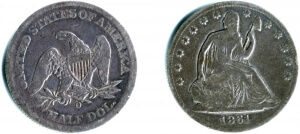
The 1861 Confederate half dollar
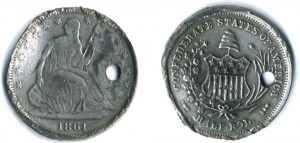
1879 Scott Confederate half dollar
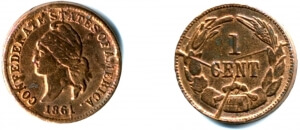
1961 Bashlow Confederate cent
